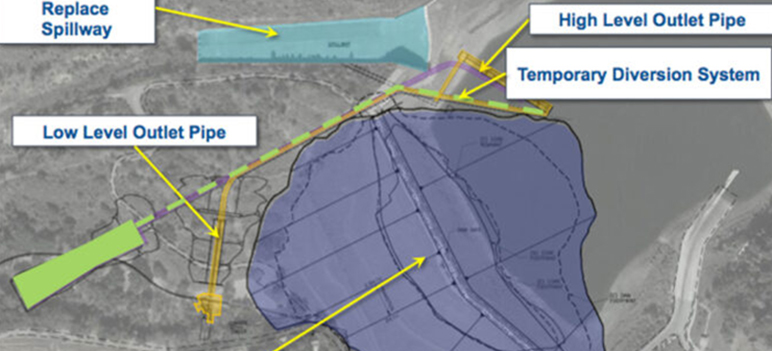Valley Water this past week began draining Anderson Reservoir in preparation for a seismic retrofit of the body’s dam in east Morgan Hill.
But Gov. Gavin Newsom also vetoed a state assembly bill that would have expedited the project that the district has been planning for more than 10 years.
Assembly Bill 3005—sponsored by 30th District Assemblyman Robert Rivas—would have hastened the rebuild and strengthening of Anderson Dam by expediting environmental review and other regulatory processes that are necessary for such a vast public works project. Newsom vetoed AB 3005 at the end of last week.
“Notwithstanding the importance of completing projects at the Anderson Dam, the bill sets unrealistic timelines for state entities to expedite deliverables,” Newsom wrote in a message about why he refused to sign the bill into law. “This [would] require staff to be diverted away from other critical projects throughout the state that are going through the CEQA process.” CEQA is the California Environmental Quality Act, a law that requires environmental review for large construction projects.
Rivas, whose district includes south Santa Clara County, and Valley Water officials said they were upset about the governor’s decision to veto the bill, known as the Expedited Dam Safety for Silicon Valley Act.
“My constituents and the greater Silicon Valley region are at risk of a catastrophic flood from a large earthquake due to the current conditions of the Anderson Dam,” Rivas said in a statement. “AB 3005 would have expedited the dam’s seismic retrofit project and was vital to ensuring the water supply and environmental benefits for the region expeditiously. The safety of my constituents is my highest priority.”
Valley Water, which owns Anderson Reservoir and its earthen dam, began draining the water body Oct. 1. All recreation and most public access to the dam and recreation areas—including boating and fishing—closed this week.
Valley Water officials expect this access will remain closed throughout the dam retrofit project. Construction is scheduled to last until about 2031.
In an Oct. 2 statement, Valley Water said they were surprised by Newsom’s veto of AB 3005. The Anderson Dam Seismic Retrofit project is needed not only to ensure the safety of the dam and downstream communities throughout the valley; it is also needed to secure the water supply for Silicon Valley, the statement said.
“The Board of Directors is fully committed to ensuring that we consider every possible policy decision to move this project along as fast as possible,” Valley Water Board Chair Nai Hsueh said. “We are thankful for the support we received from Assemblyman Robert Rivas, Congresswoman Zoe Lofgren, every state and federal representative of Santa Clara County, as well as the County, cities, labor, business, and environmental advocates. We will continue to consider paths to ask the state of California to assist us in expeditiously completing this critical project.”
In 2009, state authorities determined that Anderson Dam, which was built in the 1950s, would not withstand a major earthquake, and the crest of the dam could slump in such an event—leaving Morgan Hill underwater within minutes.
Upon further study, the local water district determined that the interior of the earthen dam could liquefy in the event of a significant earthquake on the Calaveras fault, which is about 1.2 miles from Anderson Dam.
Since 2009, as a precaution the reservoir level has been maintained below 60 percent of the reservoir’s capacity—except during occasional storms that produced heavy rainfall.
Earlier this year, the Federal Energy Regulatory Commission ordered Valley Water to begin draining Anderson to dead-pool level starting Oct. 1. In February, the state legislature approved AB 3005, which Newsom vetoed this past week.
The retrofit project will in fact begin—after the reservoir is almost fully drained in the coming months—with a new outlet tunnel that will improve the district’s ability to quickly discharge large volumes of water from the bottom of the lake into Coyote Creek. Construction of the tunnel will last about three years.
After the tunnel is complete, construction will begin on the Anderson Dam Seismic Retrofit project, which will take about 10 years to complete. Then, Valley Water will be able to allow Anderson Reservoir to return to its full capacity for the first time since the existing dam was deemed seismically unsound in 2009.
As of Oct. 2, Anderson Reservoir is holding about 18 percent of its 89,000 acre-feet capacity, according to Valley Water’s website.
The total projected cost of the tunnel and retrofit project is about $576 million.
“We are greatly disappointed by the veto of AB 3005, but Valley Water staff will continue to seek the fast-tracking of permits for the Anderson project,” Valley Water CEO Rick Callender said. “We will not quit pushing as hard as we can to get this project done quickly and safely, because the protection of life and property is our highest priority.”


“Notwithstanding the importance of completing projects at the Anderson Dam, the bill sets unrealistic timelines for state entities to expedite deliverables,” Newsom wrote in a message about why he refused to sign the bill into law.
Geez Gav – – its a ten year long project – – can’t we get some public workers to “expedite” a little quicker than that?
RECALL NEWSOM!!
He’s a jackass…
The “expediting” must have involved the diverting of money away from the pockets of State employees.
He should have vetoed it. All these years and years and yet no Environmental Impact Report was never done? Didn’t bother to see if draining the lake puts residents at risk of wildfire, either. Incompetent, but thankfully the governor is not.
The people who truly deserve the fail on this project aren’t even in government anymore. There’s really no excuse to have so many things left undone on this project of so many years in the making. Shame on Rivas for trying to ram it through and refusing to talk about the thousands of people impacted by wildfires in the area.
Shows how inept local and state government is.